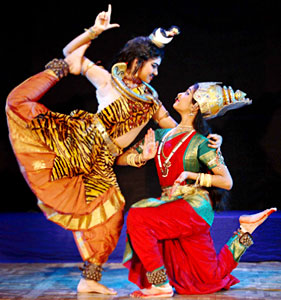 Nine Moods in Indian Classical Music are the emotions in the expression of Raagas on which the entire musical system is based. A lot of time and effort is spent by the musicians in finding and shaping the Bhava. The mood of the music is a very important component of the entire musical experience in India and it finds mention even in the earliest writings on music. It has been treated in great detail in the treatise Natyashastra of the 4th century CE. The treatise described eight primary moods, or Rasas (literally, `juice` or `sap`), which were said to play an important role in drama, dance, and music. Later, in the tenth century, a ninth Rasa was added to the list (peace) and hence the list is known as the nine Rasas, the Navarasas.
Nine Moods in Indian Classical Music are the emotions in the expression of Raagas on which the entire musical system is based. A lot of time and effort is spent by the musicians in finding and shaping the Bhava. The mood of the music is a very important component of the entire musical experience in India and it finds mention even in the earliest writings on music. It has been treated in great detail in the treatise Natyashastra of the 4th century CE. The treatise described eight primary moods, or Rasas (literally, `juice` or `sap`), which were said to play an important role in drama, dance, and music. Later, in the tenth century, a ninth Rasa was added to the list (peace) and hence the list is known as the nine Rasas, the Navarasas.
The Navaras in Indian Classical Music are-
Karuna sadness, pathos
Shringar love, joy
Vira heroism, valor
Hasya laughter, comedy
Raudra anger
Bhayanaka fear
Vibhatsa digust
Adbhuta surprise
Shanti peace
When performing a drama (which includes classical dance), it is felt that a judicious use of the first eight moods would leave the audience with a feeling of the ninth, peace. In a musical performance, the first four, and the ninth, find expression in the Raagas, or musical modes. The moods of the other four, that is, anger, fear, disgust, and surprise, are not regarded as inherent in the Raagas themselves, but rather can be combined with stage action to create a greater dramatic effect.
The shades and meaning of these moods can be described in a variety of ways. These descriptive words are called Bhavas (expressions). The Rasa Shringar ("love"), for instance, has so many Bhavas: happiness, joy, enchantment, wonder, ecstasy, infatuation, adoration, eroticism, devotion, and so on-there must be an infinite number of words to describe all the kinds of love. Bhavas are what artists spend years developing and refining, and are what communicates with and moves audiences.
Apart from the Rasas, there are other terms which are commonly used to describe the shades of feelings that can be conveyed by Raagas. According to their nature, Raagas can be classified into two groups- serious or light. A serious Raaga can be said to have a Gambhir Prakrit (serious nature). This might be said of the strictly classical literature in general. Lighter Raagas are said to have Chanchal Prakrit (restless nature). A Raaga with a devotional tradition is described as having Bhakti Ras (devotional love), to distinguish it from the more romantic nature of Shringar Ras. Also certain Raagas are said to have healing properties. However, one must be very careful when dividing the various Raagas as these may be very personalized by different artists, and one person`s concept of "heavy" in music may be approached more lightly in another`s version.




















